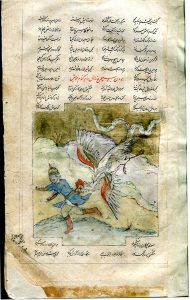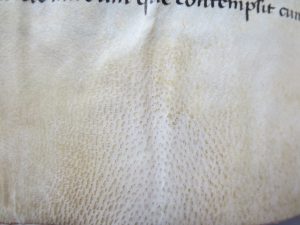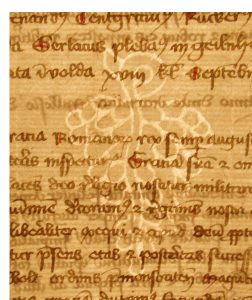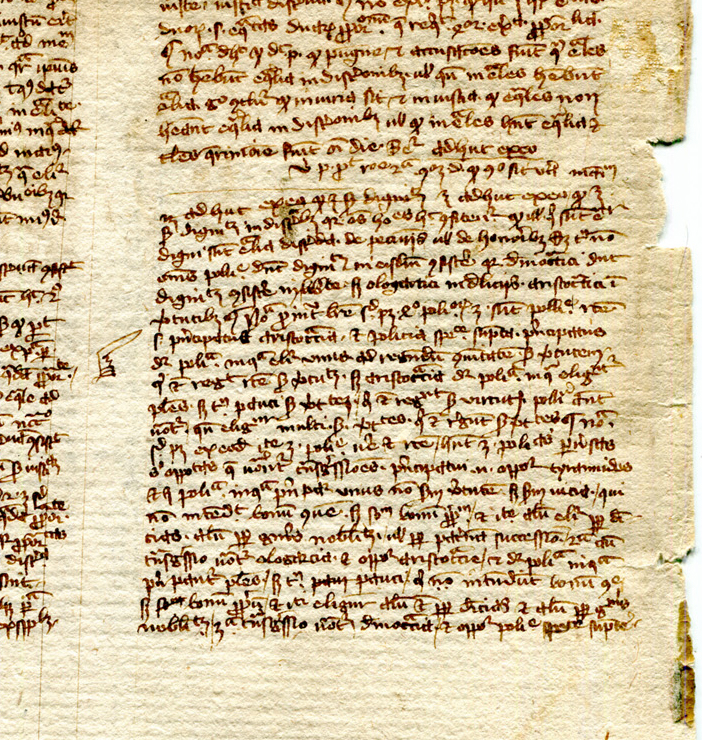2023 Autumn Symposium “Between Earth and Sky”
March 21, 2023 in Manuscript Studies, RGME Symposia, Uncategorized
2023 Autumn Symposium
“Between Earth and Sky”
Part 2 of 2 in the
2023 Spring and Autumn Symposia
on “Materials & Access”
Saturday 21 October 2023
9:30 am – 5:00 pm EDT (GMT-4) by Zoom
[Posted on 21 March 2023, with updates]
For 2023, the Year’s Theme for the Research Group is “Materials & Access”.
The RGME continues with its pair of Symposia for 2023, continuing its expanded pattern of paired day-long virtual Spring and Autumn Symposia launched in 2022.

“Centered”. Photograph Ⓒ 2014 Mildred Budny.
This year, the Spring and Autumn Symposia will take place by Zoom respectively on:
- Saturday, 25 March 2023
- Saturday 21 October 2023 (“The Sweetest Day” 2023)
Each Symposium in the pair explores a wide range of spheres, subjects, case-studies, and issues connected with the duality of Materials of many kinds and varieties of Access to them.
Part 1, “From the Ground Up”, explored the terrain for Materials and Access in a wide variety of fields.
Part 2, “Between Earth and Sky”, examines the conditions and opportunities for Materials and Access in the world as we might know it, both in the Here and Now and beyond.
1 of 2. 2023 Spring Symposium,
with a Pre-Symposium of Lightning Talks
Pre-Symposium: “Intrepid Borders” (24 March 2023)
Spring Symposium: “From the Ground Up” (25 March 2023)
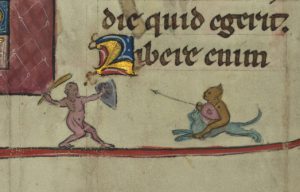
Baltimore, Walters Art Museum, MS. W.148, folio 33v, bottom right. Image via Creative Commons.
The Spring Symposium acquired a companion event, in the form of a half-day virtual Pre-Symposium with Lightning Talks selected from responses to a Call for Proposals and organized by Katharine C. Chandler, Jennifer Larson, and Jessica L. Savage.
Information about these companion events, which took place on Friday afternoon 24 March and all day Saturday 25 March 2023:

The blooms of Snowdrops emerging “From the Ground Up”. Photograph Ⓒ Mildred Budny.
The 2023 Spring Pre-Symposium/Symposium Booklet records the Program for both events and the Abstracts for their Presentations, with Illustrations. The digital version can be downloaded freely here in two formats, for your printing facilities and preferences.
- Consecutive Pages (quarto size, or 8 1/2″ × 11″ sheets)
consecutive pages - Foldable Booklet (11″ × 17″ sheets), to be folded in half
foldable booklet
2 of 2. 2023 Autumn Symposium:
“Between Earth and Sky”
Saturday 21 October 2023 by Zoom

Ravenna, Mausoleum of Galla Placidia, Ceiling Mosaic. Photo: Petar Milošević / CC BY-SA, Wikipedia.
Grounded in the experiences and expertise of our fields of study, our 2023 Autumn Symposium might take notice of view-points across time and place which can inform and enlighten our explorations of materials, memory aids, and forms of understanding transmitted from the past.
Note on the Image
With an eye toward the heavens, a visitor looking upward in the late-antique Mausoleum of Galla Placidia, created for an empress in Ravenna, Italy, can glimpse the mosaic ceiling patterned with star-studded and celestial skies of deep blue.
Photograph by Petar Milošević, via CC BY-SA License via Wikipedia.
Participants
Participants for the 2023 Autumn Symposium, variously as Presenters, Respondents, Presiders, Moderators, and Advisers, include (in alphabetical order):
- Phillip A. Bernhardt-House, Mildred Budny, Barbara Williams Ellertson, Hannah Goeselt, Justin Hastings, Jennifer Larson, Laura Light, John McQuillen, Ann Pascoe-van-Zyl, Ronald Patkus, David Porreca, David W. Sorenson, Kathy Young, N. Kıvılcım Yavuz, and others.
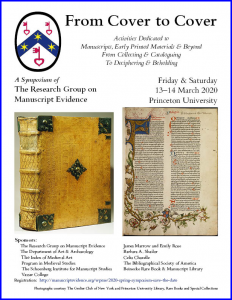
2020 Symposium Poster 1
Among them are Speakers who now reprise or offer a variant on the papers which they planned for the RGME 2020 Spring Symposium in person at Princeton University. Their illustrated Abstracts for that cancelled event describe the intentions then. See 2020 Spring Symposium (Save the Date) and the published Symposium Booklet, available as a pdf laid out
- in consecutive pages,
- or as foldable booklet.
A similar Symposium Booklet is planned for the 2023 Autumn Symposium.
For the Preliminary Program for the 2023 Autumn Symposium, see below. As it takes fuller shape, its details will appear here. For an e-version of the companion Symposium Booklet, see below.

Cambridge, Trinity College, MS O.3.7, fol. 1r. Frontispiece image of Philosophy Personnified for Boethius, De consolatione philosophiae, with commentary. Image via CC 4.0 International License, via https://mss-cat.trin.cam.ac.uk/Manuscript/O.3.7
A ‘Poster Person’
As a beacon for the event, we reflect on the majestic standing figure of Lady Philosophy appearing as a frontispiece in a Late Anglo-Saxon manuscript. Standing upright with a steady frontal gaze, wrapped in flowing garments, she rests her feet upon hilly ground, while she holds up to the sides an elongated book in one hand and a foliate scepter in the other. This is a favorite book and image.
Preliminary Program
(For Registration, see below.)
Speakers, Respondents, and Presiders for the event include the Director and Associates of the RGME as well as others.
Recording. We will record the event for our records, also with the aim of making the recording available for viewing afterward, subject to processing and permission.
Please watch this space for updates.
Schedule and List of Presentations
(the order may vary)
Full Day: 9:30 am to 5:00 pm EDT (GMT-4) with breaks
Morning
Session 1. “Sources, Resources, and Encounters”
9:30–11:15 am EDT (GMT-4)
Presider: Jennifer Larson (Classics Department, Kent State University)
- Mildred Budny (Director, Research Group on Manuscript Evidence)
“Opening Remarks”
- Kathryn Young (University Archivist / Curator of Rare Books, Loyola University Chicago)
and
Justin Hastings (Assistant Teaching Professor, Department of English, Loyola University Maryland)
“Crowning a King, Interpreting Society, and Scaring the Kids:
First-Year Composition Students Meet the Archives and Special Collections”
- Ronald Patkus (Head of Special Collections and College Historian, Adjunct Associate Professor of History on the Frederick Weyerhaeuser Chair, Vassar College)
“Preview of 2024 RGME Spring Symposium at Vassar College”
— April 2024 (hybrid):
“Between Past and Future:
Building Bridges between Special Collections and Teaching for the Liberal Arts”

London, British Library, Cotton MS Julius A. VI, fol. 4v, detail.
Lunch Break. 11:15 am – 12:30 pm EDT (GMT-4)
Afternoon
Session 2. “By Land and By Sea”
12:30-2:00 pm EDT (GMT-4)
Presider: Hannah Goeselt (Library, Massachusetts Historical Society, Boston)
- Ann Pascoe-van-Zyl (Ph.D. Candidate, Department of English, Trinity College Dublin)
“Affective Landscape Imagery in the Old English Psalms and the Old English Elegies”
- Eleanor Congdon (Department of Humanities and Social Sciences, Youngstown State University, Ohio)
“Letters to Ambrogio Malipiero, a Venetian Vice Consul in Syria during the 1480s“
- David Porreca (Department of Classical Studies, University of Waterloo, Kitchener, Ontario)
“An Introduction to the Edgar William Pyke Coin Collection at the University of Waterloo”
- David W. Sorenson (Allen G. Berman, Professional Numismatist)
“Response: Collecting and Studying Coins as Records of History” [if David’s variable work timetable permits him to attend]
Break. 2:00–2:30 pm EDT
Session 3. “Having a Look, Looking Anew, and Looking Forward”
2:30–4:00 pm EDT
Presider: Jessica L. Savage (Art History Specialist, Index of Medieval Art, Princeton University)
- Laura Light (Director and Senior Specialist, Text Manuscripts, Les Enluminures, Chicago, New York, and Paris)
“Do Manuscript Descriptions Influence Scholarship?
The Case of Thirteenth-Century Latin Bibles”
- John T. McQuillen (Associate Curator, Printed Books and Bindings, Morgan Library and Museum, New York)
“Ars moriendi Blockbooks: What Can Watermarks in Paper Tell Us?”
- Barbara Williams Ellertson (The BASIRA Project: Books as Symbols in Renaissance Art and Research Associate of the Schoenberg Institute for Manuscript Studies, University of Pennsylvania Libraries, Philadelphia)
“A Preview of a new Open Access Resource: Searching the BASIRA Project Database”
Break. 4:00–4:30 pm EDT
Presider: David Porreca
Session 4. “Accessing Materials / Bridging Time and Place”
4:30–5:00 pm EDT (GMT-4)
- Phillip Bernhardt-House (Academic Vagabond)
“A Few Reflections on Materials and Their Access:
Accessibility Concerns and Scholarship”
- Mildred Budny
Concluding Remarks:
“From ‘Materials and Access’ in 2023 to ‘Bridges’ in 2024:
Accomplishments and Prospects for an Anniversary Year”

2023 Autumn Symposium Booklet Cover.
The Illustrated Symposium Booklet
As the Symposium approaches, the illustrated Symposium Booklet becomes ready.
Our practice is to make the illustrated Symposium Booklet available close to the time of the event, for distribution in printed and digital formats. The e-version (in pdf format) will be downloadable in two formats:
- as consecutive pages.
- as foldable booklet.
Registration for the 2023 Autumn Symposium
To register for the event, visit the RGME Eventbrite Collection.
- RGME Events on Eventbrite.
- 2023 Autumn Symposium Tickets.
General Admission
or
Admission with Voluntary Donation
Registration is required; there is no charge for admission. We welcome donations.
Donations for our mission and activities may be tax-deductible. Registering for the event offers an option for you to make a donation easily and conveniently. See also
We thank you for your interest and support.
More Information and Updates
Watch this space for more information as it unfolds.
Questions? Ask director@manuscriptevidence.org.
2023 RGME Events
Other events are planned for the Year. See
The next episode for this online series is Episode 14 on Sunday 19 November 2023
2:00-2:30 pm EST (GMT-5) by Zoom. See
2024 RGME Events for an Anniversary Year
Announcements of our events planned for 2024 are coming soon. Some will be announced for the 2023 Autumn Symposium. They include:
- 2024 Spring Symposium at Vassar College:
“Between Past and Future:
Building Bridges between Special Collections and Teaching for the Liberal Arts”.
Suggestion Box
Please Contact Us or visit
- our FaceBook Page
- our Twitter Feed (@rgme_mss)
- our Blog on Manuscript Studies and its Contents List
Donations and contributions, in funds or in kind, are welcome and easy to give.
We look forward to hearing from you.

“Centered”. Photograph Ⓒ 2014 Mildred Budny.
*****

